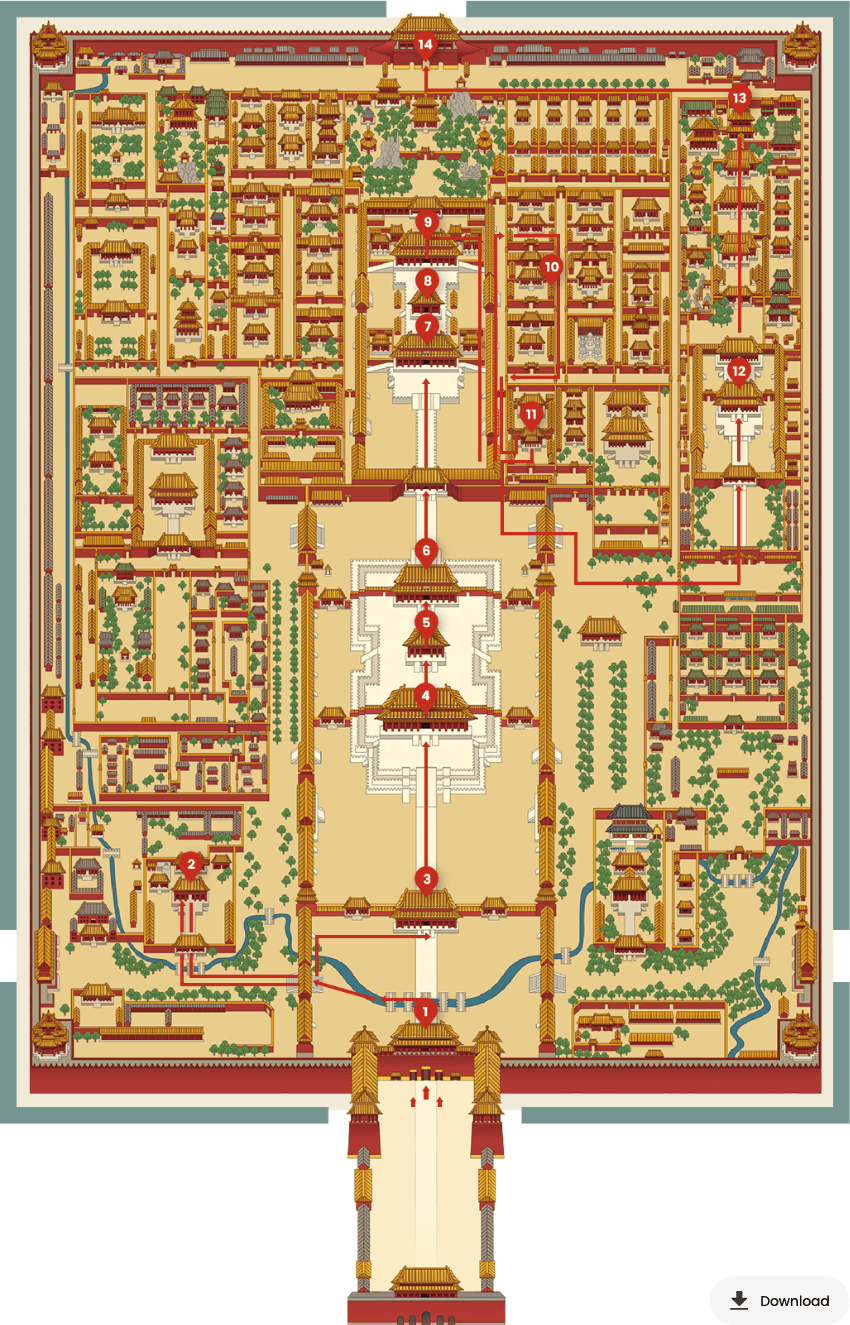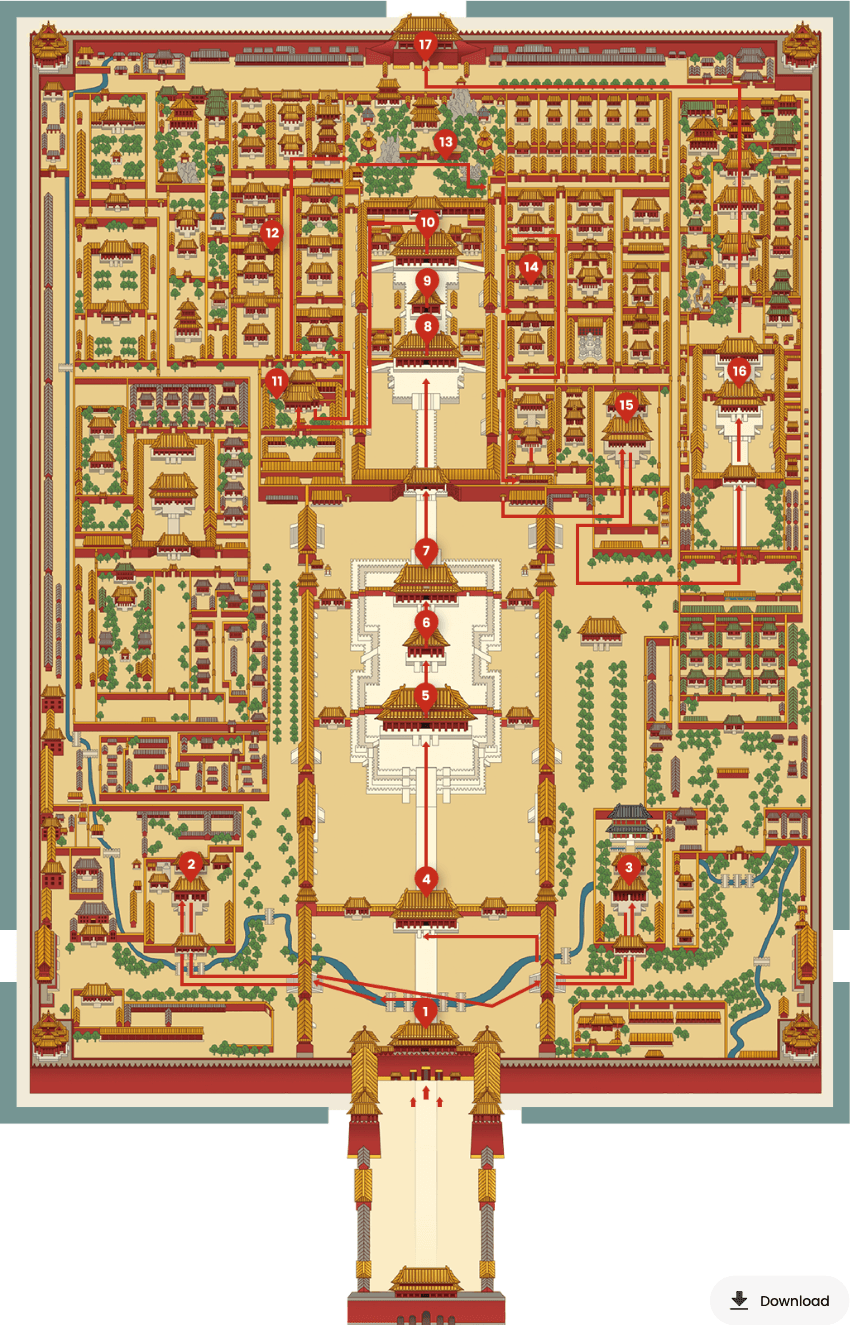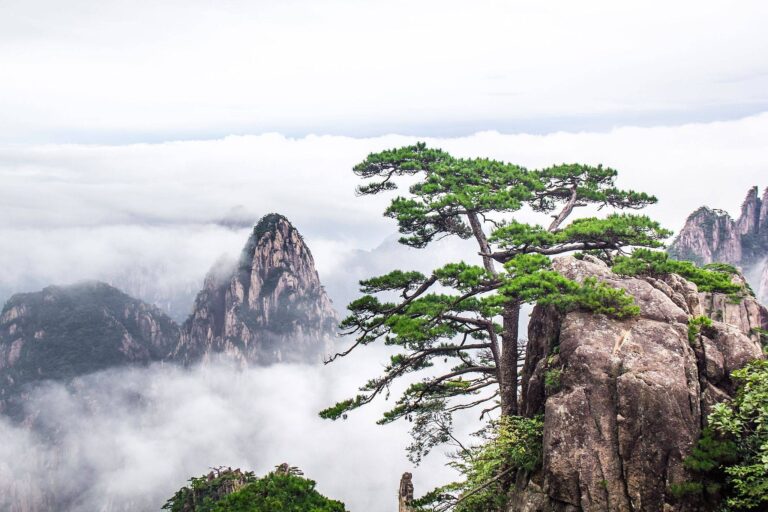Forbidden City
Standing at the heart of Beijing, the Forbidden City represents China’s most magnificent architectural achievement and cultural treasure. As someone who has guided countless travelers through its vermillion gates and golden halls, I can tell you that no journey to China is complete without experiencing this UNESCO World Heritage masterpiece. This comprehensive guide will equip you with everything needed for an unforgettable visit to the world’s largest palace complex.
Quick Facts
Opening Hours: 8:30 AM–5:00 PM (peak), 8:30 AM–4:30 PM (off-season), closed Mondays.
Location: Central Beijing, China, north of Tiananmen Square.
Chinese Name: Gùgōng (故宫, Former Palace) or Zǐjìnchéng (紫禁城, Purple Forbidden City).
Area: 72 hectares (178 acres), with 980 buildings.
Construction: Built from 1406 to 1420 under Emperor Yongle (Ming Dynasty).
Historical Role: Home to 24 emperors (14 Ming, 10 Qing) for 492 years.
Current Status: Palace Museum, established in 1925, housing 1.8 million artifacts.
UNESCO Status: World Heritage Site since 1987.
Visitor Numbers: Approximately 19.3 million annually (pre-COVID, 2019 data).
Ticket Price: CNY 60 (peak season, April–October), CNY 40 (off-season, November–March).
Table of Contents
History and Cultural Significance
The Ming Dynasty Foundation
The Imperial Palace of the Ming and Qing Dynasties in Beijing known as the Forbidden City was constructed between 1406 and 1420 by the Ming emperor Zhu Di and witnessed the enthronement of 14 Ming and 10 Qing emperors over the following 505 years. Emperor Yongle, the third Ming ruler, relocated China’s capital from Nanjing to Beijing, commissioning this extraordinary palace complex to demonstrate imperial power and legitimacy.
The construction required extraordinary resources and human effort. Sources say it took 100,000 artisans and a million forced laborers to build the Beijing complex, utilizing materials from across the empire. Precious nanmu wood came from Sichuan and Yunnan provinces, while the famous golden roof tiles were crafted using advanced techniques that remain impressive today.
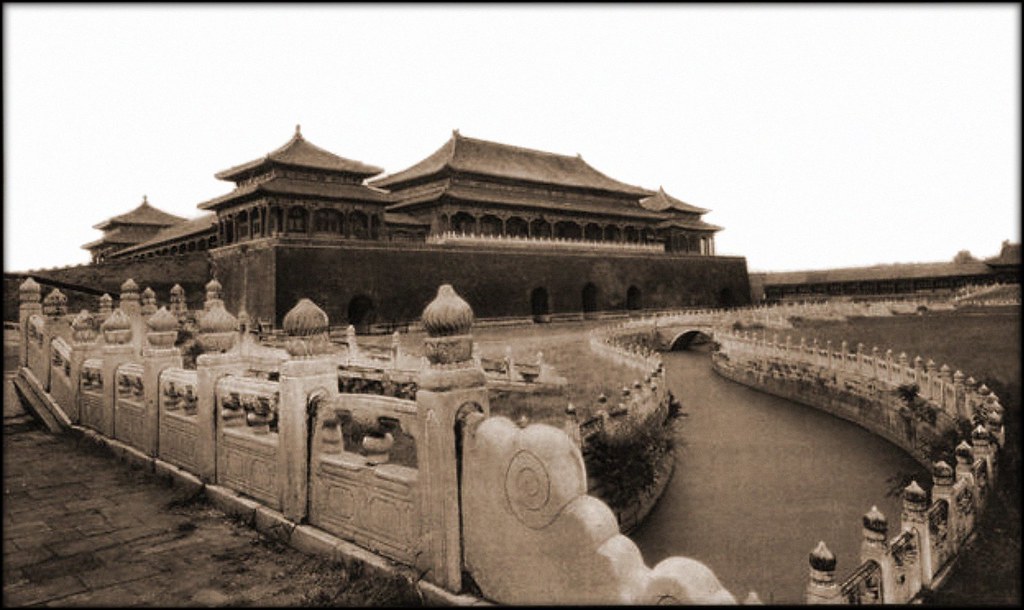
Imperial Life and Rituals
For nearly 500 years, the Forbidden City served as China’s political and ceremonial center. The palace layout reflects traditional Chinese cosmology and Confucian hierarchy. The southern section housed public ceremonial halls where emperors conducted state affairs, while the northern residential quarters provided private spaces for the imperial family.
Daily life within these walls followed strict protocols. Only the emperor, his family, court officials, and thousands of servants could enter. Common citizens were forbidden from approaching, hence the name “Forbidden City.” This exclusivity created an air of mystery that persists today, drawing millions of curious visitors annually.
Architectural Philosophy and Symbolism
The palace design embodies feng shui principles and Chinese architectural philosophy. The north-south axis alignment represents cosmic order, while the color scheme carries deep meaning. Yellow roof tiles symbolized imperial power, as yellow was the emperor’s exclusive color. Red walls represented happiness and prosperity, while the white marble foundations suggested purity and stability.
The number nine appears throughout the palace, from door studs to architectural elements, representing the emperor’s supreme status in Chinese numerology. Even today, visitors can observe these symbolic details that transformed functional architecture into profound cultural expression.
Why the Forbidden City is Worth Visiting
Unparalleled Historical Significance
Visiting the Forbidden City offers an unprecedented glimpse into Chinese imperial history. Walking through the same courtyards where emperors made decisions affecting millions provides a tangible connection to China’s past. The palace witnessed pivotal moments including the Ming-Qing transition, the Boxer Rebellion, and the end of imperial rule in 1912.
Unlike reading about history in books, experiencing these spaces firsthand creates lasting memories. The scale and grandeur remain overwhelming even by modern standards, demonstrating the extraordinary resources and artistic achievement of imperial China.
Architectural Masterpiece
The Forbidden City represents the pinnacle of traditional Chinese architecture. The harmonious balance between buildings, courtyards, and landscapes creates visual poetry in built form. Each hall showcases different architectural styles and decorative techniques, from intricate wooden joinery to elaborate ceiling paintings.
The palace’s preservation allows modern visitors to experience Ming and Qing dynasty craftsmanship virtually unchanged. This authenticity becomes increasingly rare in our rapidly modernizing world, making the Forbidden City an irreplaceable cultural treasure.
World-Class Museum Collections
Beyond architecture, the Palace Museum houses over 1.8 million cultural artifacts spanning 5,000 years of Chinese civilization. The collections include paintings, ceramics, jade, bronze, clocks, and imperial costumes of exceptional quality and historical significance.
Regular special exhibitions showcase different aspects of the collection, ensuring return visits offer new discoveries. Recent exhibitions have featured everything from ancient Chinese painting masterpieces to imperial court life recreations, providing educational and cultural enrichment for visitors of all ages.
Cultural Understanding and Appreciation
Experiencing the Forbidden City deepens understanding of Chinese culture, values, and artistic traditions. The palace embodies concepts like harmony, hierarchy, and the mandate of heaven that continue influencing Chinese society today.
For international visitors, the palace provides crucial context for understanding modern China’s relationship with its imperial past. This cultural insight proves invaluable for anyone seeking to understand China beyond surface impressions.
Must-See Highlights and Hidden Gems
The Meridian Gate (Wu Men)

Your journey begins at the imposing Meridian Gate, the Forbidden City’s main entrance. This five-pavilion structure served as the emperor’s ceremonial gateway, where imperial edicts were announced and military victories celebrated. The gate’s massive scale immediately establishes the palace’s grandeur and importance.
Climbing the gate’s central walkway, reserved exclusively for emperors, provides your first panoramic view of the palace complex. This elevated perspective helps visitors appreciate the careful planning and symmetrical layout that defines the entire complex.
Hall of Supreme Harmony (Taihe Dian)
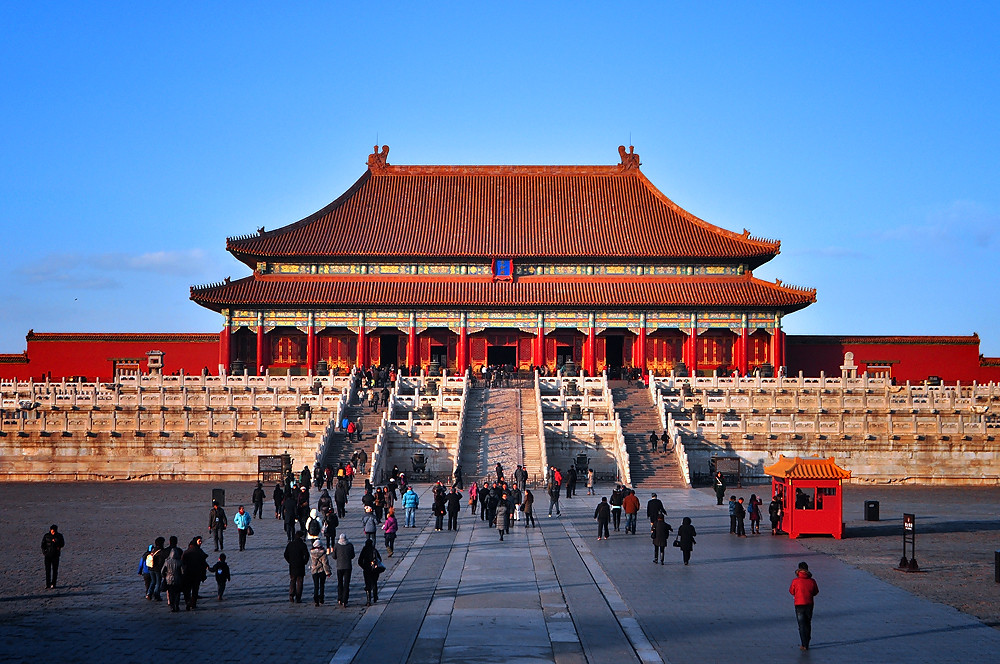
The Hall of Supreme Harmony stands as the Forbidden City’s most important building and China’s largest surviving wooden structure. This magnificent hall hosted coronations, weddings, and other major imperial ceremonies. The building’s yellow glazed roof tiles, marble dragon carvings, and elaborate interior decorations exemplify imperial Chinese architecture at its finest.

Inside, the Dragon Throne sits beneath an intricately carved ceiling featuring a coiling dragon holding a pearl in its mouth. This symbolism represents the emperor’s divine mandate and supreme authority. The hall’s perfect acoustics allowed the emperor’s voice to carry clearly throughout the space during important ceremonies.
Hall of Central Harmony and Hall of Preserving Harmony
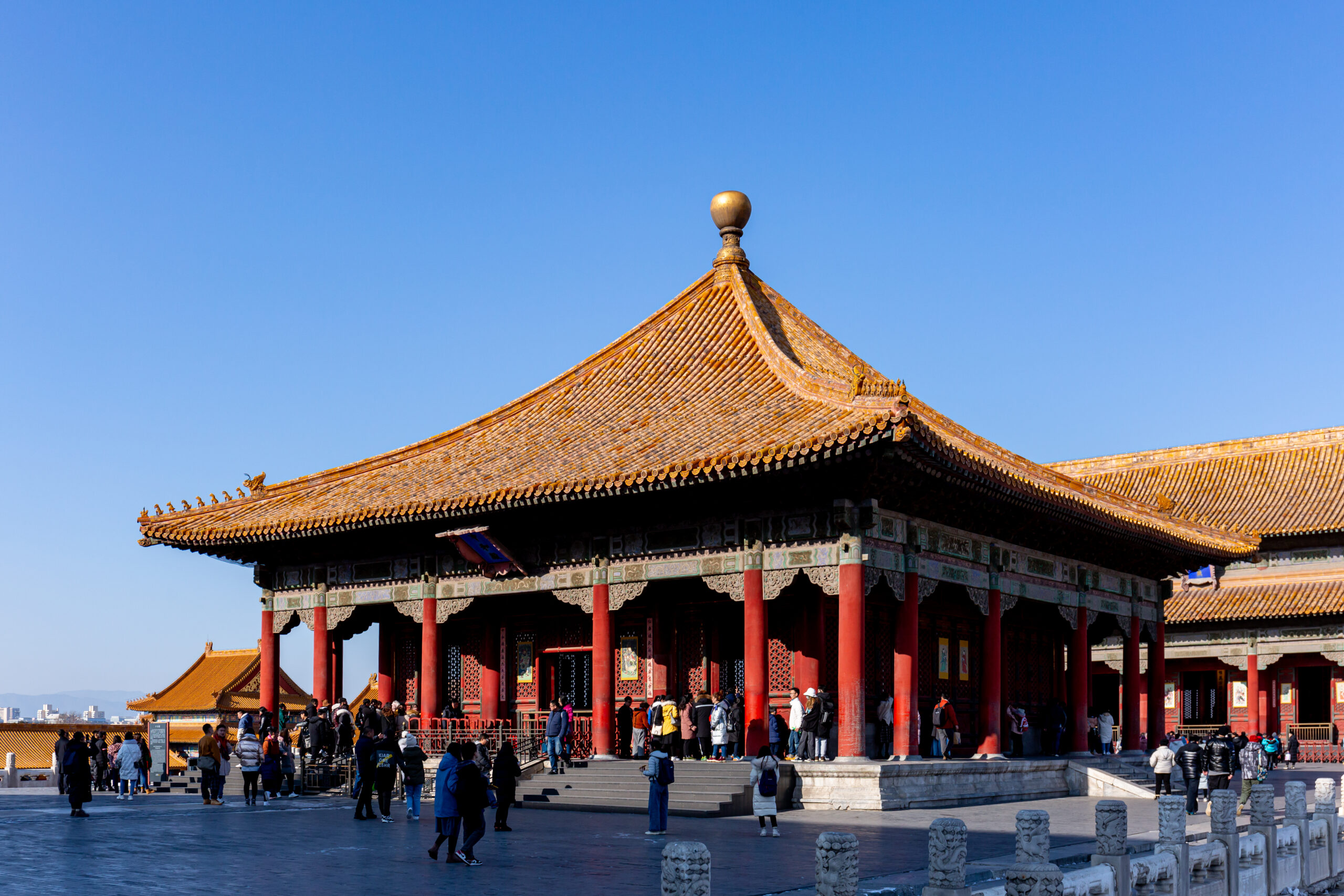
These smaller halls served specific ceremonial functions within the imperial complex. The Hall of Central Harmony functioned as a preparation area where emperors reviewed speeches and received officials before major ceremonies. The Hall of Preserving Harmony hosted imperial examinations and New Year’s Eve banquets.
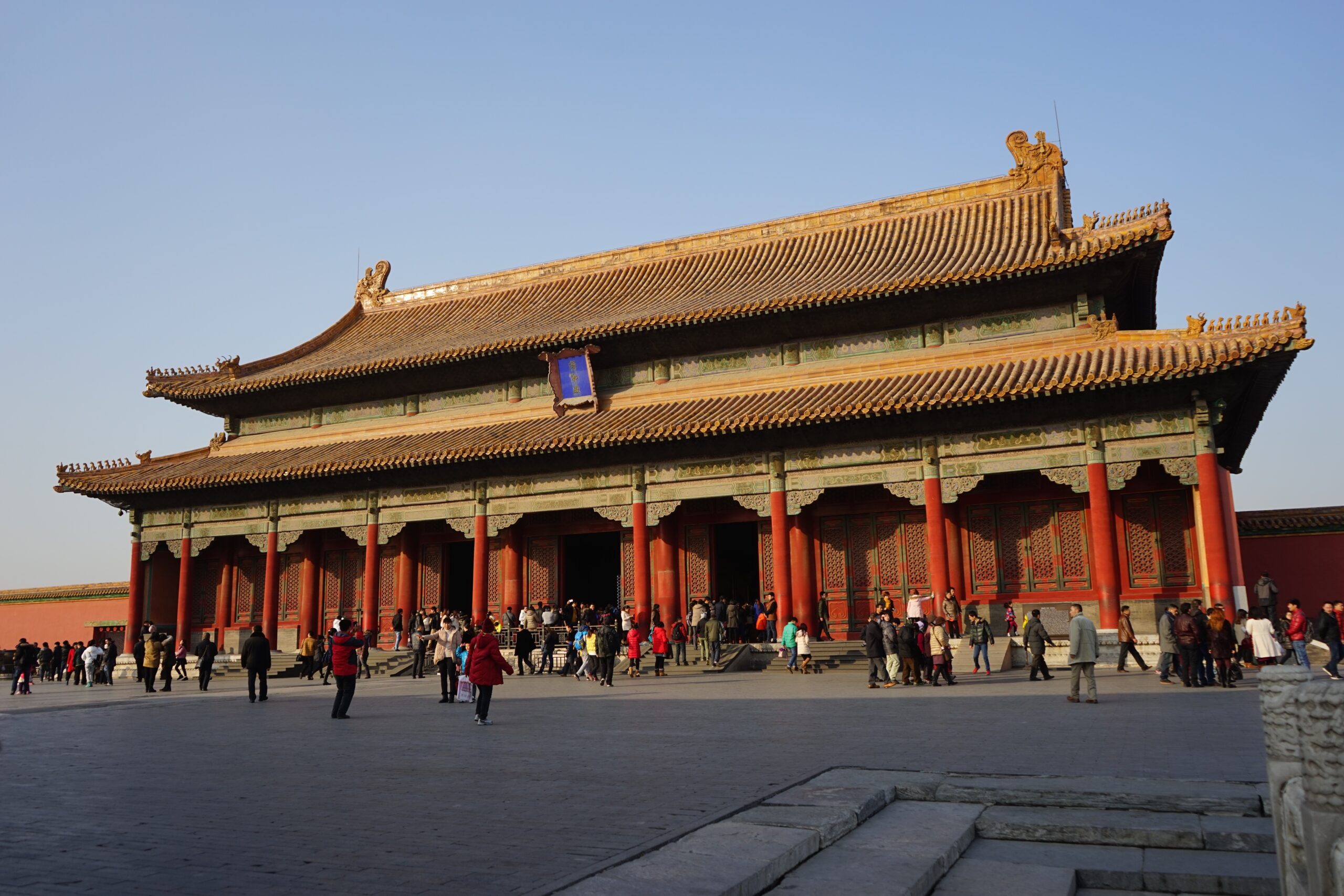
Each hall features unique architectural details and historical significance. The marble ramp behind the Hall of Preserving Harmony, carved with dragons among clouds, represents one of the palace’s finest sculptural achievements.
Palace of Heavenly Purity (Qianqing Gong)
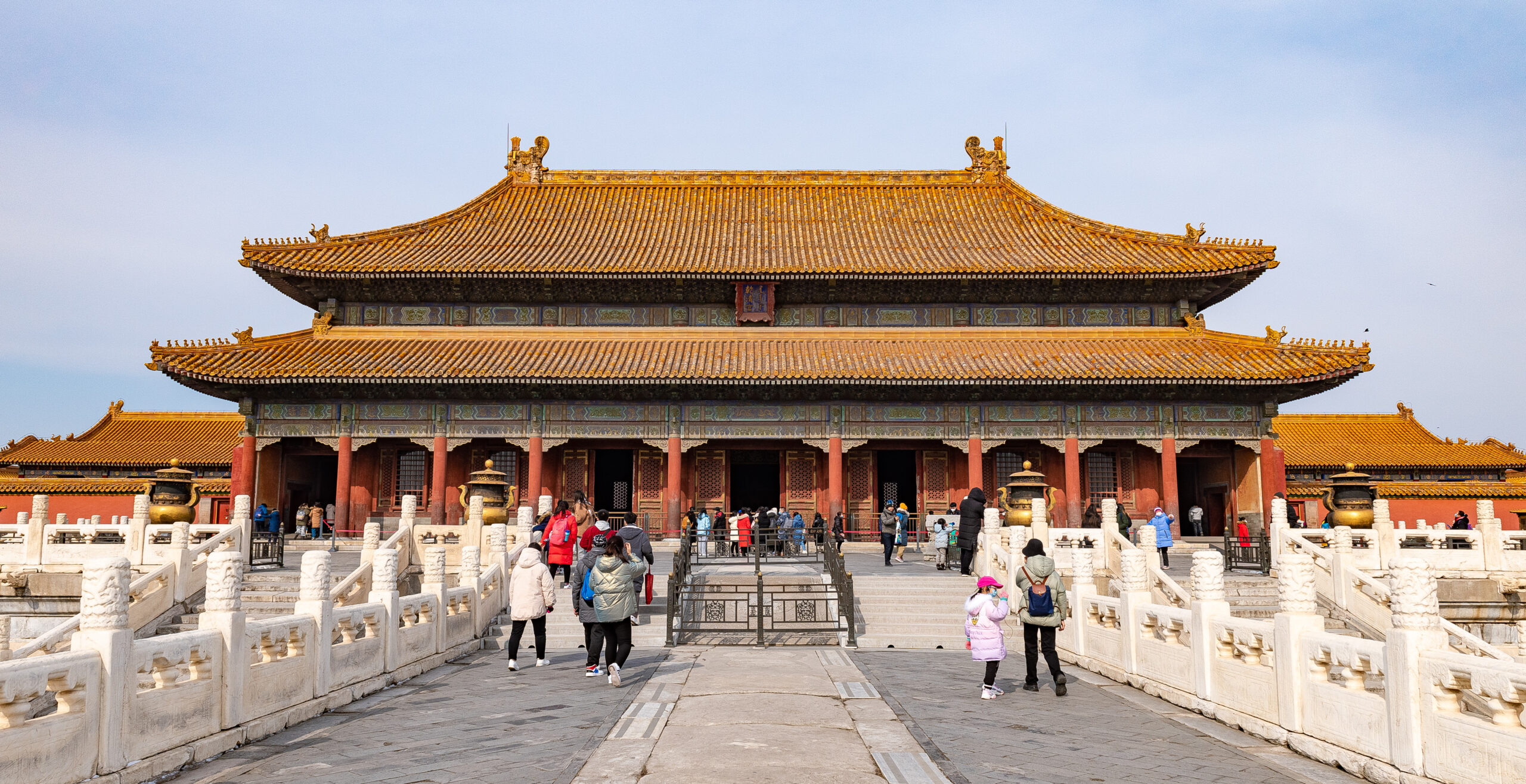
The Palace of Heavenly Purity marked the transition from public ceremonial spaces to private imperial residences. This hall served as the emperor’s bedroom during the Ming dynasty and later became an audience hall for receiving ministers and foreign dignitaries.

The palace’s interior recreates imperial living conditions with period furniture, decorations, and personal items. Visitors can glimpse the private side of imperial life, including the emperor’s daily routines and family relationships.
Imperial Garden (Yuhuayuan)

The Imperial Garden provides a peaceful conclusion to your palace visit. This carefully designed landscape features ancient cypress trees, ornate pavilions, and artificial rock formations representing classical Chinese garden design principles.
The garden’s seasonal beauty changes throughout the year, from spring blossoms to autumn colors. The central Pavilion of Imperial Peace offers excellent photo opportunities and a moment of tranquility after exploring the palace’s grand halls.
Hidden Treasures and Lesser-Known Areas
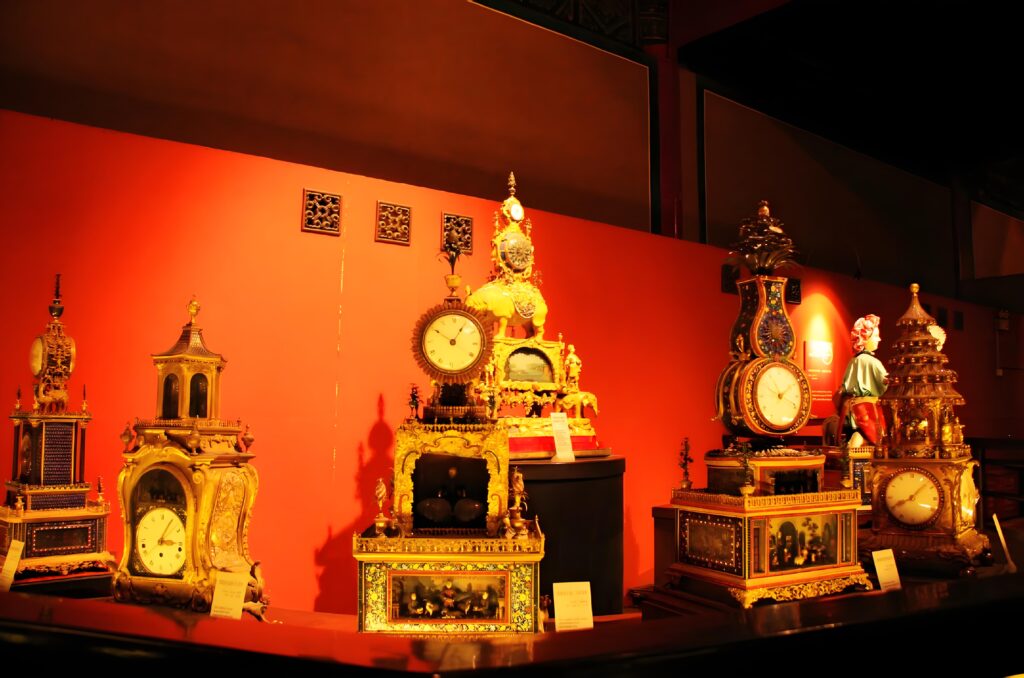
Beyond the main tourist route, the Forbidden City contains numerous hidden gems worth discovering. The Clock Exhibition Hall showcases an impressive collection of timepieces from around the world, many still functioning after centuries.
The Treasure Gallery displays imperial jewelry, gold objects, and ceremonial items that demonstrate the extraordinary wealth and craftsmanship of the imperial court. These smaller exhibitions provide intimate encounters with Chinese artistry and imperial luxury.
Practical Travel Tips for Your Visit
Essential Preparation
Successful Forbidden City visits require advance planning and preparation. Security checks take 15-20 minutes, longer during peak season. There are two checkpoints: one at Tiananmen Square, and another at the palace entrance. Bring your passport for ticket collection and security clearance. Comfortable walking shoes are essential, as you’ll cover several kilometers exploring the palace complex.
Weather protection becomes crucial during Beijing’s extreme seasons. Summer visits require sun protection, water, and cooling strategies, while winter visits need warm clothing and preparation for potentially icy conditions. Spring and autumn offer the most comfortable visiting weather.
Navigation and Route Planning

The Forbidden City’s massive scale can overwhelm first-time visitors. Following the central north-south axis provides the most comprehensive experience, covering all major halls and courtyards. Allow at least four hours for a thorough visit, though photography enthusiasts and history buffs often spend entire days exploring.
Audio guides enhance the experience significantly, providing historical context and architectural explanations for major buildings and artifacts. The official Palace Museum app offers multilingual commentary and interactive maps that help navigate the complex’s winding pathways.
Recommended Visitor Trails
Photography and Documentation
Photography policies within the Forbidden City have specific restrictions. While exterior photography is generally permitted, many interior halls prohibit flash photography to protect ancient artifacts and decorations. Special exhibition areas may have additional restrictions that visitors should respect.
The best photography opportunities occur during golden hour periods, approximately one hour after opening and before closing. Early morning visits provide fewer crowds and better lighting conditions for architectural photography.
Cultural Etiquette and Respect
Visiting the Forbidden City requires appropriate cultural sensitivity and respect. This sacred space represents Chinese national heritage and cultural identity. Visitors should maintain quiet voices, avoid touching artifacts or decorations, and follow designated pathways.
Understanding basic Chinese cultural concepts like hierarchy, harmony, and respect for authority enhances the visiting experience. These values permeate every aspect of the palace design and historical significance.
Best Time to Visit the Forbidden City
Seasonal Considerations
The best time to visit the Forbidden City is during the early spring (April to May) and autumn (late September to early November), when the weather is mild. These seasons offer comfortable temperatures, clear skies, and moderate crowd levels that enhance the overall experience.
Spring visits coincide with blooming flowers in the Imperial Garden, creating beautiful photographic opportunities and pleasant walking conditions. Autumn provides crisp air, clear visibility, and comfortable temperatures ideal for extended exploration.
Summer visits, while popular, present challenges including intense heat, humidity, and maximum crowd levels. However, summer also offers the longest daylight hours and lush garden scenery. Winter visits provide unique atmospheric experiences but require preparation for cold temperatures and potential snow.

Daily Timing Strategies
Arrive 30 minutes early, especially between 9-11 AM. Arrive at 7:30 AM for the best experience with minimal crowds. Early morning visits provide optimal lighting conditions, comfortable temperatures, and peaceful exploration opportunities before tour groups arrive.
Late afternoon visits, particularly during weekdays, offer another strategy for avoiding peak crowds. The golden light during late afternoon creates excellent photography conditions and highlights the palace’s architectural details beautifully.
Special Events and Exhibitions
The Palace Museum regularly hosts special exhibitions featuring different aspects of its vast collection. These temporary displays often showcase rarely seen artifacts and provide unique insights into specific historical periods or artistic traditions.
National holidays and festivals create both opportunities and challenges for visitors. While these periods offer special cultural programs and celebrations, they also attract maximum crowds and require advance booking for guaranteed entry.
Special Experiences and Insider Secrets
Behind-the-Scenes Access
Advanced visitors can arrange special access tours that include areas normally closed to the public. These exclusive experiences provide deeper insights into palace conservation efforts, artifact preservation techniques, and ongoing archaeological discoveries.
Private guide services offer personalized experiences tailored to specific interests, whether architectural history, imperial court life, or artistic traditions. These specialized tours provide expert commentary and access to lesser-known palace areas.
Seasonal Highlights and Hidden Details
Each season reveals different aspects of the Forbidden City’s beauty and character. Winter snow creates dramatic contrasts against the red walls and golden roofs, while spring brings blooming magnolias and flowering trees throughout the palace grounds.
Experienced visitors learn to notice subtle details that most tourists miss: carved stone dragons hidden in stairway balustrades, symbolic animal figures protecting building corners, and intricate ceiling paintings in smaller halls.
Cultural Programs and Educational Opportunities
The Palace Museum offers cultural programs including traditional craft demonstrations, historical reenactments, and educational workshops. These programs provide hands-on experiences that complement the architectural and historical exploration.
Language exchange programs sometimes occur in the palace, allowing international visitors to interact with Chinese students and cultural enthusiasts while exploring this shared heritage site.
Photography and Documentation Secrets
Professional photographers and experienced visitors know specific locations and timing that create exceptional images. The reflection pools near the Hall of Supreme Harmony provide mirror images during calm weather conditions.
Early morning mist occasionally creates atmospheric conditions that transform the palace into an ethereal landscape resembling traditional Chinese paintings. These rare moments require patience and weather luck but produce unforgettable images.
Frequently Asked Questions

How long does a typical visit take?
A comprehensive Forbidden City visit requires minimum four to six hours, though many visitors spend entire days exploring the complex. First-time visitors following the main north-south route typically need four hours, while those exploring side courtyards and exhibition halls may require six to eight hours.
Photography enthusiasts and history buffs often return multiple times to fully appreciate different aspects of the palace. The vast scale and rich details reward repeated visits with new discoveries and deeper understanding.
What should I bring for my visit?
Essential items include your passport for entry, comfortable walking shoes, weather-appropriate clothing, and a water bottle. Cameras are permitted in most areas, though flash photography restrictions apply in certain halls.
Additional recommended items include portable phone chargers, small snacks, sun protection during summer, and warm clothing during winter. The palace gift shops sell souvenirs but at premium prices compared to external retailers.
Are there dining options inside the palace?
Limited dining options exist within the Forbidden City complex, primarily basic cafeterias serving simple meals and beverages. Most visitors prefer eating before or after their palace visit at nearby restaurants offering more variety and better value.
The surrounding Dongcheng district provides excellent dining options representing various Chinese regional cuisines and international alternatives. Planning meal timing helps maximize palace exploration time.
Is the palace accessible for visitors with mobility limitations?
The Palace Museum provides wheelchair access to major halls and courtyards, though some areas remain challenging due to traditional architecture featuring steps and uneven surfaces. Wheelchair rental services are available with advance notification.
Accessible route maps highlight barrier-free pathways and elevator locations. Visitors with mobility concerns should contact the museum directly for specific accessibility information and assistance planning.
Can I visit the same day I arrive in Beijing?
Same-day visits are possible but not recommended for international arrivals due to potential jet lag and ticket availability issues. You can only book earliest 1 week in advance through the official website, making advance planning essential.
First-time Beijing visitors benefit from adjusting to the time zone and exploring nearby areas before tackling the Forbidden City’s extensive complex. This approach ensures optimal energy levels and appreciation for the palace experience.
What’s the difference between peak and off-peak seasons?
Peak seasons (summer months and major Chinese holidays) feature maximum crowds, higher temperatures, and premium pricing but also extended operating hours and special cultural programs. Off-peak periods offer more comfortable visiting conditions with moderate crowds and pleasant weather.
International visitors often prefer shoulder seasons (late spring and early autumn) that balance comfortable weather with manageable crowd levels. These periods provide optimal photography conditions and relaxed exploration opportunities.
Planning Your Visit: Getting There, Opening Hours and Tickets
Transportation Options
The Forbidden City’s central Beijing location provides excellent public transportation access. Subway Line 1 connects to Tiananmen East and Tiananmen West stations, both within walking distance of the palace entrance. These stations serve multiple subway lines, facilitating convenient transfers from anywhere in Beijing.
Bus services provide alternative transportation with multiple routes stopping near Tiananmen Square and the Forbidden City. Route numbers 1, 2, 10, 20, and 52 offer direct access, though subway transportation typically proves faster and more reliable during peak hours.
Taxi services provide convenient door-to-door transportation, though traffic congestion around Tiananmen Square can cause delays during busy periods. Ride-sharing apps like Didi offer similar services with English-language interfaces for international visitors.
Ticket Booking and Pricing
Foreigners can now use email and passport to book Forbidden City (Palace Museum) tickets through official website with only 6 easy steps. Online booking remains essential as walk-up tickets are rarely available, especially during peak seasons and holidays.
You can also book though their official WeChat mini program:

Current pricing structure varies by season: April-October, 60 CNY; November-March tickets cost 40 CNY for standard admission. Additional fees apply for special exhibitions and audio guide rentals. Student discounts are available with valid identification.
Third-party booking platforms charge premium fees but may offer package deals including transportation and guide services. However, official website booking provides the most reliable access and competitive pricing for individual visitors.
Operating Hours and Schedule
Opening hours: April-October: 8:30am-5:00pm, last entry at 4:10pm / November-March: 8:30am-4:30pm, last entry at 3:40pm. Closed on Mondays. These schedules accommodate seasonal daylight variations and visitor flow management.
Monday closures allow maintenance and conservation work while managing visitor numbers throughout the week. It is closed on Mondays, except the Chinese statutory holidays. Holiday schedules may vary, requiring verification before travel planning.
Early arrival proves advantageous for several reasons: reduced crowds, better photography lighting, comfortable temperatures, and maximum exploration time before fatigue sets in. Late afternoon entries risk feeling rushed due to closing time constraints.
Security and Entry Procedures
Palace entry requires passing through multiple security checkpoints similar to airport procedures. If you plan to enter the Forbidden City through Tiananmen Square, please ensure that you have made a prior reservation for Tiananmen Square. This additional requirement affects visitors planning the traditional approach through the square.
Security screening includes bag X-rays, metal detectors, and identity verification. Prohibited items include large backpacks, professional photography equipment, food, and beverages (except water). Storage facilities near the entrance provide options for restricted items.
Identity documents remain essential throughout the visit, as random checks occur within the palace complex. International visitors should carry passports, while domestic visitors need valid Chinese identification cards.

Group Tours versus Independent Visits
Independent visits offer maximum flexibility for exploration timing, photography, and personal interests. Self-guided visitors can spend additional time in preferred areas while moving quickly through less interesting sections.
Group tours provide expert commentary, historical context, and guaranteed access but limit individual exploration freedom. Many visitors combine approaches by joining tours for major highlights then exploring independently afterward.
Private guide services offer personalized experiences with flexible scheduling and specialized knowledge tailored to specific interests. These premium services prove particularly valuable for first-time visitors seeking comprehensive understanding of palace history and culture.
Conclusion
The Forbidden City stands as one of humanity’s greatest architectural and cultural achievements, offering visitors an unparalleled journey through Chinese imperial history. From its magnificent halls and intricate artwork to its profound cultural significance, every aspect of this UNESCO World Heritage site deserves careful exploration and appreciation.
Your visit to Beijing’s crown jewel will create lasting memories and deeper understanding of Chinese civilization spanning over 600 years. The palace complex rewards careful planning, cultural sensitivity, and open-minded exploration with experiences that few other destinations can match.
Whether you’re drawn by architectural beauty, historical significance, or cultural curiosity, the Forbidden City delivers transformative experiences that extend far beyond typical tourist attractions. This living museum continues revealing new secrets and insights with each visit, making it a destination worthy of return trips and extended exploration.
The investment in visiting the Forbidden City pays dividends in cultural understanding, artistic appreciation, and personal enrichment that last long after your Beijing journey concludes. Few places on earth offer such comprehensive insights into human achievement, cultural values, and historical continuity.
A Personal Note from Our Team
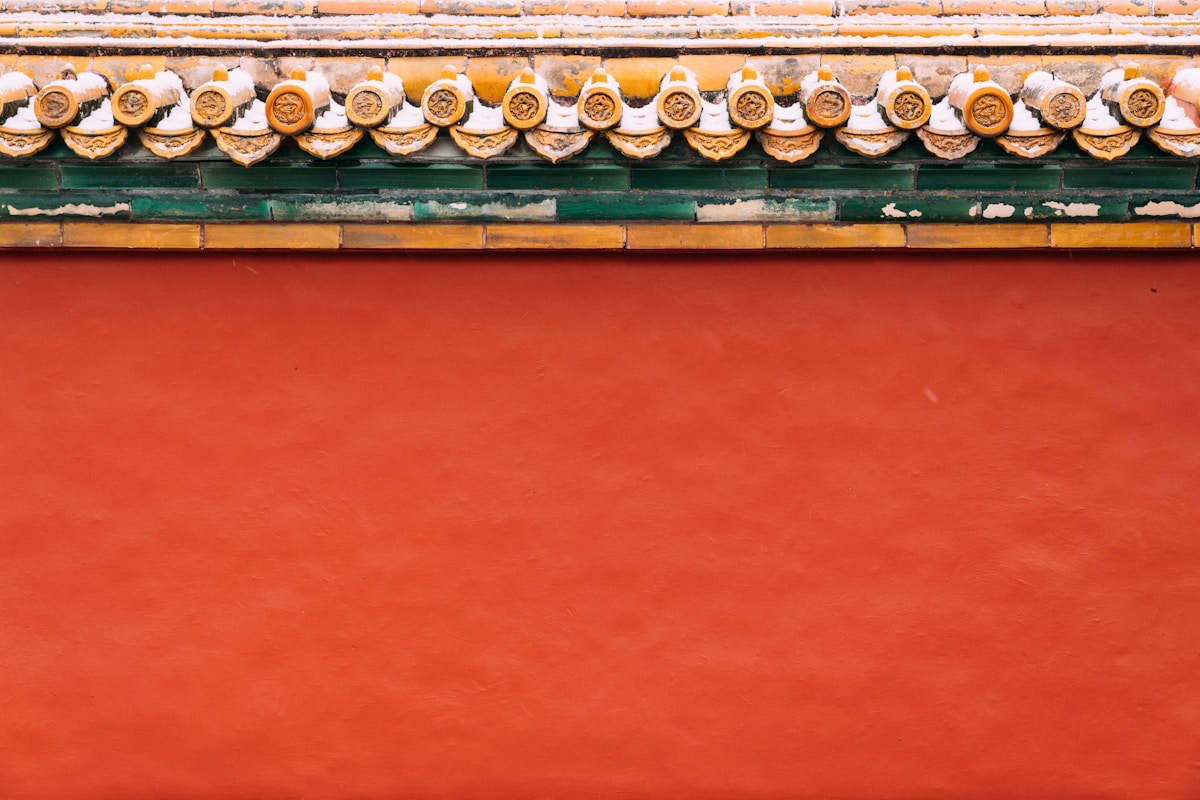
Having guided thousands of travelers through the Forbidden City’s magnificent halls and courtyards, our team understands the profound impact this experience creates for visitors from around the world. We’ve witnessed first-time visitors standing speechless before the Hall of Supreme Harmony’s grandeur, photographers capturing perfect reflections in the marble courtyards, and history enthusiasts discovering hidden details that textbooks never revealed.
Our expertise comes from years of practical experience helping international visitors navigate language barriers, cultural differences, and logistical challenges that can complicate independent travel in China. We’ve learned which timing strategies work best for different travel styles, how to avoid common tourist mistakes, and where to find those special moments that transform good trips into unforgettable adventures.
The Forbidden City represents everything we love about Chinese travel: ancient history preserved for modern appreciation, architectural beauty that inspires awe, and cultural insights that deepen global understanding. Our team’s passion for sharing these experiences drives our commitment to providing accurate, practical, and insightful travel guidance.
Every recommendation in this guide comes from real experience helping travelers like you create meaningful connections with Chinese culture and history. We understand that visiting the Forbidden City represents more than sightseeing—it’s an opportunity for cultural bridge-building and personal growth that extends far beyond your Beijing stay.
Trust our expertise to help you plan and execute the perfect Forbidden City visit. Our team stands ready to answer questions, provide additional guidance, and ensure your Chinese adventure exceeds every expectation. Contact Travel China With Me for personalized assistance that transforms travel dreams into cherished memories.




